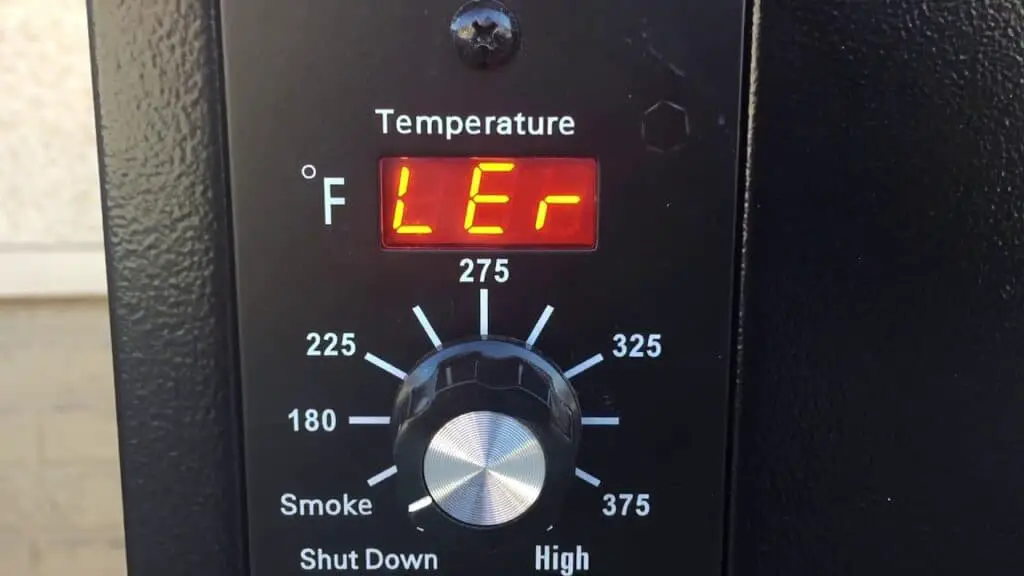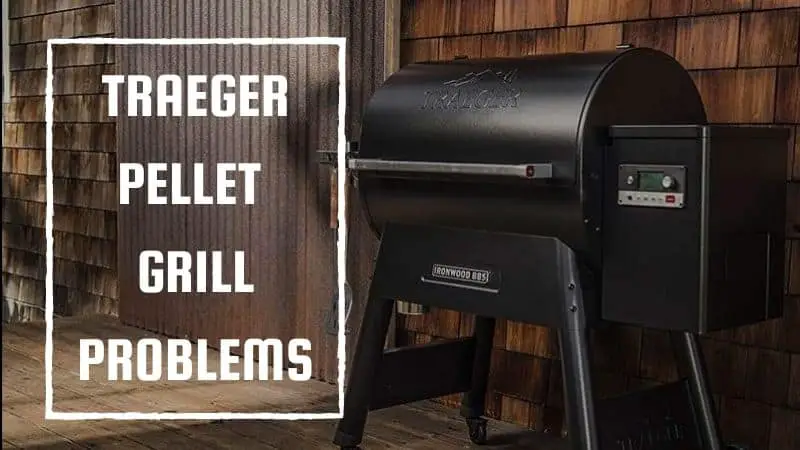Traeger pellet grills are one of the most popular brands on the market today. However, it is not uncommon for these units to stop working properly at some point during their lifetime. This post will outline some common problems and Traeger error codes that people experience with their Traeger grills and offer possible solutions to fix them.
Traeger Pellet Grill Problems
Unusual Temperature Variations
It is typical for the Traeger pellet oven’s temperature to vary by up to 15-20F above or below the temperature goal you’ve selected. This is all part of the rod and auger’s regular cycle. Pellets are put into the rod as it cools and then ignited. When it becomes too hot, it comes to a halt for a little while.
It’s vital to know that the temperature you’ve selected is the average temperature the grill will maintain during the cooking process! As a result, temperature variations of 15 to 20 degrees Fahrenheit are perfectly normal, given the architecture.
Solution:
However, extreme fluctuations outside of this period may indicate a problem. So, what is it precisely?
The first step is to pause for a minute and reflect that this is quite normal. Bear in mind that a fluctuation of 15-20F is normal for an entire cook under optimum circumstances. If the outside temperature is very cold or extremely hot, the Traeger must work harder to compensate for the heat.
It is possible to detect temperatures that are beyond the range that are not caused by the grill in these situations. Protect your grill from the elements and reduce the effect of weather.
If you’re confident you’re not in the weather, the fire pit is an excellent place to check. The fire pit was designed with many openings to guarantee proper ventilation. If holes are formed as a result of our old adversary’s corrosion, this results in an increase in airflow and warmth.
If corrosion is detected, check the drip pan and heat diffuser for damage. If there are more of them than necessary, they will generate excessive heat in the Traeger.
Your pellets may also be suspects. Pellets of inferior quality may produce a significant amount of Ash. Not only may ash clog ventilation openings, but if there is enough spread around the room, it can cause the sensor to provide misleading readings.

Fire Extinguished
Have you ever waited all day for your meat to cook on the barbecue only to discover it still raw? As frightening as it may seem, the flame on the grill often goes out. If it occurs on your face and you are present to revive it, it may become challenging.
The issue with the burning fire is related to a number of the same issues that arise when the temperature changes. Certain components, such as the fire pot, must be replaced or cleaned since they are inadequate to maintain the fire. There may be an excessive amount of ash or rust in the fire pit, obstructing ventilation and leading the fire to go out.
As with the other possible causes, another possibility is that something is wrong with the induction motor. This fan is intended to provide oxygen to the flame in order to maintain it; if it fails to do so, the fire will spread out of control. Additionally, a more common and visible issue is that the pellets are too low in the hopper, leaving insufficient fuel to sustain the flame.
It’s also conceivable that it’s because the pellets are of poor quality and produce an excessive amount of ash, which obstructs airflow to the fire. The temperature sensor may be showing erroneous temperatures as a result of insufficient pellets reaching the auger. Additionally, it may be because the day is windy.
Solution:
As previously noted, if you detect any indications of wear on any of the components, you should immediately replace them. To prolong the life of your grill, clean the grill grate after each use, remove the ash every two or three weeks, and do a complete cleaning of your grill at least twice or three times each year.
There are a number of possible causes and remedies for why the fan isn’t functioning, which we’ll discuss in a minute. If you’re suffering an excessive quantity of ash, you may choose from a variety of pellet kinds and store them safely to extend their life. A higher-quality pellet will prevent your grill from overheating in a short amount of time.
Additionally, you may keep the grill on for long periods of time without running out of pellets. If the problem is entirely with the thermometer, a simple replacement should resolve the issue.
Pellets Are Refusing to Pass
You don’t have to stand beside the grill and keep adding pellets constantly because the Traeger grill comes with an automated auger and hopper that can do the work for you. But many grilling lover persons face this problem that the pellets not moving from the hopper to the firepot.
Solution:
In this situation, you’ll need to remove your toolbox and then open it to reveal a few grill components, particularly the hopper’s side. If you discover that the primary source of the issue is the motor, you’ll need to replace or repair it; if the motor is jammed, you’ll need to get it cleared. You’ll next need to assemble the barbecue and enjoy it without incident.
The Grill Isn’t Heating Up
Inadequate heat means that the items you’re cooking will take longer to cook, which may be frustrating. It may even be dangerous, depending on the meal you’re cooking or preparing, since raw meat poses a health risk.
Solution:
Before you start, check to ensure that the grill is properly lit. Remove the heat diffuser, pellets drip pan, and cooking grates from the oven. Then extinguish the flame. Examine the firepot to see whether the igniter is burning red. If not, contact Traeger to arrange for a replacement.
Additionally, you may be experiencing an issue with an induction fan. When you turn on your grill, listen for a buzzing noise. A faulty fan will result in an insufficient amount of oxygen entering the cooking chamber. This implies that the pellets will be incapable of catching fire. Additionally, it is possible to verify that the fan is not positioned incorrectly.
Traeger Grill Not Lighting
The power is switched on (this is the first place to check for problems!). The auger spins and the pellets fall into the fire pit, but nothing ignites. Here’s a simple issue to tackle.
Solution:
The most probable cause is that the igniter is defective. Experiment with operating the grill without pellets. Then remove the drip pan and grates from your heat diffuser so that you can see straight into the fire pit. The tip of the ignitor should be illuminated crimson. If it does not, there is an issue. What does this entail? to dial Traeger’s number!
Additionally, this might be a fan issue. When the fan is not running, there may be insufficient oxygen in the air for the pellets to collect. You may listen for the sound of the fan’s motor to see whether it is operating properly.
The Grill Is Not Turning On
The gas or charcoal grills do not need electricity to start, but the Traeger grill must. It’s a common and simple problem for the one who is utilizing it. The more powerful components, such as induction fans and auger motors, need energy to operate and contribute to the aesthetic appeal of a barbecue.
Solution:
The problem may be addressed by repairing or replacing the faulty components. Occasionally, the grill does not need powering owing to a faulty GFCI, a blown circuit, or an inadequate power outlet.
Traeger Error Codes
HEr – High Temperature Error
HEr is an abbreviation for High-Temperature Error. This error number indicates that the temperature inside your grill has exceeded 550degF for more than 45 minutes. When this occurs, the grill begins cooling down, which shuts off the fan and auger. Once the grill reaches a temperature of less than 450 degrees Fahrenheit The auger then re-engages and operates for another two minutes to clear any residual embers in the tube that goes through the auger.
HEr-related issues often occur as a result of the following:
- On the grill, there is an abundance of ash and grease.
- The temperature probe is malfunctioning.
- Pellets of wood that are not of high grade.
- Temperature control issues.
Depending on the cause of the problem, a professional remedy may be required. If a temperature-related problem occurs while cooking, it is possible that your meal will not be able to be recovered.
LEr – Low Temperature Error

If the grill’s display indicates an error code LEr, the grill’s temperature is less than 130 degrees Fahrenheit. This may occur if you’ve set it for a very slow and low-pitched smoke, or if you’ve run out of wood pellets or they’re dusty, or if the fire grate is clogged with dirt and grime. It’s possible that it’s a chilly and windy day and your barbeque isn’t producing enough heat. In this case, just raise the temperature of your grill and you’ll be OK.
However, if the weather seems to be favorable, you should take the following measures to verify:
- Dust-check the fire pit. Ascertain that your grill is clean, since this may be contributing to your low temperature.
- A heat sensor may be malfunctioning. Restart the procedure and monitor its progress.
- Perhaps there is an issue with the P-setting, sometimes referred to as the ‘p setting. Additionally, you must restart it.
- These are the most probable problems that may arise with your grill. However, if the issue becomes more severe, you’ll need to seek professional assistance unless you’re an expert at grill repair.
Low Ambient Temperature
This error occurs when the ambient temperature falls below -20°F for more than 30 seconds. If the temperature is over 40 degrees, you will be unable to operate on the grill until the controller has been warmed up.
ERR – Bad Probe
Typically, the ERR error code indicates an issue with the RTD (Resistance Temperature Detector). The probe is used to check the grill’s interior temperature.
If the sensor probe becomes loose, it will be repaired quickly. All that is needed is that the connection be tightened. However, this error message may signal a more serious problem with the RTD, which may need replacement or repair by a skilled expert.
Probe Fell Out
This error message will appear when the probe used to measure the meat is removed. The error should be resolved by reinserting the probe.
ER1 – Temperature Sensor Out
This error will occur if the thermocouple is disconnected from its controller for longer than 10 minutes. Connect the thermocouple to resolve the problem.
ER2 – Short Circuit /Defective RTD
If you noticed an error code shown on the grill’s screen, this indicates an electrical short in the circuit. Turn off the electricity and call experts to insulate the wires and tighten the connections. Occasionally, the error message indicates that the smoker’s connection is poor.
Conclusion: Traeger Troubleshooting
Repairing and maintaining Traeger grills may be challenging if you lack a comprehensive knowledge of how the technology and smoker work. If, on the other hand, you’re eager to correctly maintain your grill’s high-tech features and prevent future difficulties, you can watch many lessons on YouTube and also study guides to find the answer to different technical concerns. The following are some resources for you to peruse and learn from:
